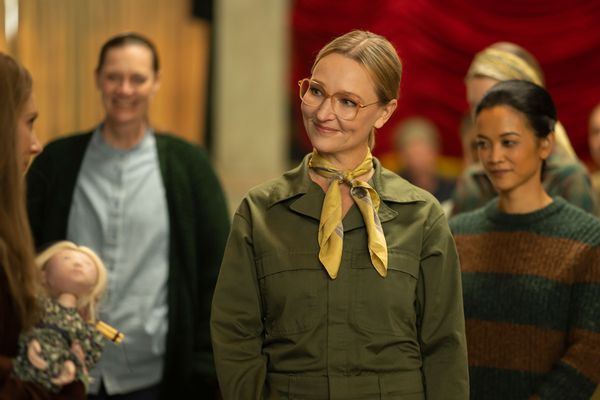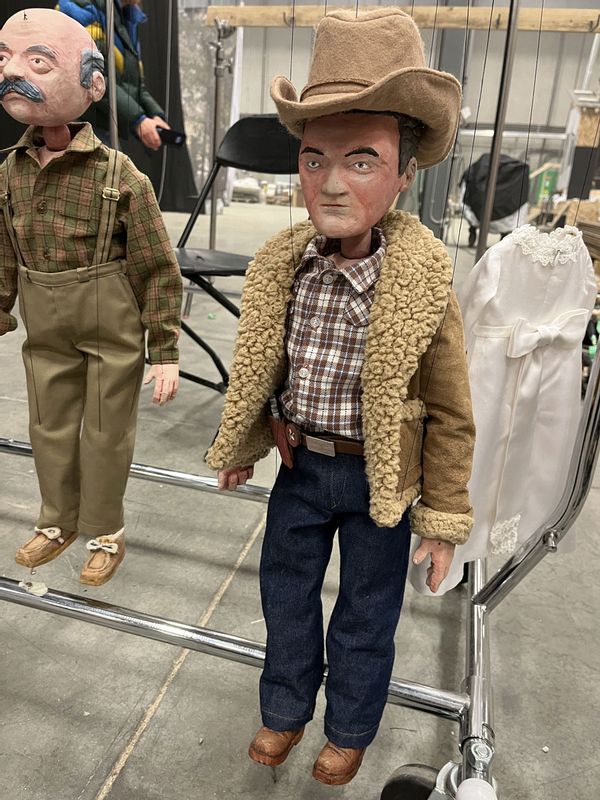
Surrealism is a calling card in Joel and Ethan Coen’s films, although in the main it is atmospheric as opposed to episodic. The trippiest tangents ascend into fully realized psychedelia, taking us out of the action and into the “life of the mind,” as the “Barton Fink” script immortally described it.
If you think of oddity as the LSD of visual storytelling — best in small hits over the long haul instead of massive wallops to the cranium — you can understand why Noah Hawley’s “Fargo” refrains from constantly straying too far over the line into eccentricity. These are still crime stories, and TV has rules about that, namely that the audience should be able to make sense of what’s happening regardless of how colorful the characters may be.
Some departures from the mundane are the best way to tell difficult stories, as the series does in the fourth season’s “East/West” episode by showing how differently white America treats a Black child stranded in Kansas than, say, a white orphan girl running away with her dog Toto.
Season 5 continues that “Wizard of Oz” connection by naming Juno Temple’s scrappy heroine Dorothy Lyon, but her port in a storm isn’t a wonderland or Camp Utopia, as it claims to be. It’s a cultish cabin full of domestic abuse survivors who call each other by one name. It casts her as Goldilocks in a den full of she-bears.
“Linda,” which Hawley co-wrote with April Shih, is the seventh episode of a season centered on a woman who lives in peace until her past rears up to devour her and anyone who would get in its way. But the nature of what happened in her past life, though obvious in the fact that she fled it, is left to the imagination. Telling stories of abuse on TV is tough to do without seeming exploitative or traumatizing the audience, and doubly challenging when the storyteller’s goal is for the viewer to keep seeing its protagonist as a survivor and not a victim.
Indira (Richa Moorjani) says as much in the previous episode when she forcefully points out to Lorraine (Jennifer Jason Leigh) that Dot, her daughter-in-law, never asked for anything from her billionaire mother-in-law – not for money, or protection, nothing. Indira, a local cop, only gets involved because it’s her job, and Dot asks a single favor of Indira to keep her daughter safe while Dot ventures out to confront her demons.
Dot drives down a country road in a Kia minivan, struggling to stay awake before pulling into a diner, where a waitress asks her if she’s running to something or from something. She doesn’t answer, ordering a pancake instead, which the waitress brings her after drawing a smiley face in whipped cream and berries across the top.
Truth is, Dorothy can’t take down her abusive, murderous ex-husband Roy Tillman (Jon Hamm) without help from the other woman to liberate himself from his clutches, Roy’s first wife Linda (Kari Matchett). Gator’s mother.
Linda left breadcrumbs for Dorothy to follow if she were ever to break free from her cage, sending a postcard from a place called Camp Utopia that Dot buried in a cache under an old windmill. Dot finds it, digs it up, reads its short message of "I'm sorry" and follows the signs to the place, driving until her car runs out of gas before walking through the dark snowy woods. At the end of the path is another kind of holding area: a blissed-out conclave made up of self-sufficient women living in limbo between hell and a new life.
They can leave whenever they’re ready, and announce their new identity, but only after they expel their stories before the others in a puppet show.

On one level, this is an artful way to portray the separation survivors use as a mechanism to live through the worst moments of their lives and the memories of those moments they can’t shake, bury or exorcise.
The choice to portray the horror of what Dorothy experienced through using marionettes is directly allegorical, in that the sexual and physical abuse to which Roy subjected Dot happened when Dorothy was a teenager he could control with violence.
Puppets also have a haunting innocence about them, fitting Dorothy’s tale of being a 15-year-old survivor of abuse and rape. (In hindsight, that makes that “helpless hitchhiker” character Roy’s third wife alludes to in their sex play more sinister than it already was.) The puppet show Dot walks in on looks like an especially evil Punch and Judy play, with the "husband" hand puppet hitting the "wife" one with a stick, making a sharp clacking sound each time he makes contact.
Dorothy passes out at this sight, and when she comes to a “Linda” keeping vigil greets her. The woman moves her lips, but what Dots hears – “Said the baby bear to the mama bear, ‘Someone’s been sleeping in my bed . . . she’s still there,” – doesn’t match what the woman is saying, at first.
But then she explains the place’s purpose to Dot: “When you leave a man who abuses and controls you, and you find this place, you take on a new name. A transition name. Linda.”
Dot’s Linda, she discovers, is Saint Linda, to which she responds with a sarcastic laugh. Dot’s Linda, see, is the one who lured her into Roy’s clutches when she was a teenage runaway escaping another unspecified violence portrayed only as wolves.
When Dorothy finds Linda, after socking her across the jaw, she demands Linda come with her to the police to tell them about Roy’s violence against them. But Linda imperiously demurs, telling Dot she owes her nothing and referring to the abuse she sustained as a choice. A nearby Linda suggests a trial; since “Saint Linda” already told them her truth, Dot has to provide hers, using the puppet. Only then, they say, can the “true truth” be determined and Dorothy fully claim her name.
The details of the puppet set, by the way, are astoundingly precise. On a set visit in the spring, a few reporters were given a tour of the Tillman ranch, including its kitchen and main room. “Fargo” sets tell a potent story by themselves, and one accent you may not have noticed is the impudent double meanings in the surroundings.
The wallpaper is an example – its repeating pattern consists of three small hens gathered near a larger rooster along with paintings of stallions and bulls, and that tells you all you need to know about Roy’s concept of the way the world should be. You might not have noticed it in the live-action scenes, but the dioramic sets on which Dot’s puppet show was filmed make everything larger than life.
Smaller, too, when the need arises. Roy’s grooming and the violence he inflicted on Linda and Dorothy is horrendous and disgusting, but we can absorb it the way Dot had to because it’s not happening to her. Some harder part inside takes the blows for her, the shame and the anger.

We understand, as she does, that all this happened to a girl named Nadine. Nadine is the puppet. Dorothy is the woman who emerged whole and real when her life became magic.
After the show, Linda agrees to accompany Dorothy, and once they're back on the road Dorothy thanks the previous Mrs. Tillman for helping her protect the life she fought so hard to build.
Mid-gratitude, however, the scene cuts back to the diner where she still sits with her pancake, with her Kia parked in the lotoutside.
When is this? Where is Linda? These questions may not cross our mind until Dorothy exits the diner and is heading toward her car when a speeding semi-truck comes out of nowhere, blazing through parked cars to crush her minivan, throwing a vehicle into her and sending her flying.
Dorothy wakes up in the hospital asking for Linda when a nurse informs her that she came into the hospital by herself.
That is the point at which, if we weren’t doing so already, we question everything. Maybe Dorothy fell asleep at the wheel as "Linda" began instead of shaking herself awake again. Maybe the song we should have paid more attention to is the one playing before "I'm Your Puppet," David Ramirez's "My Love Is a Hurricane" with its foreboding sweet nothings refrain of, "You got to know, wherever you go/ I'll be right there beside you . . .You can't escape my love."
Maybe the diner, the camp, the Lindas, and Linda Tillman, are plays in Dot's subconscious, glimpse into the life of her mind.
One recurring nightmare isn’t a figment, which is the man who her nurse says is her husband and tells her has been waiting for her to wake up. It isn’t Wayne. It’s Roy.
The end of “Linda” never establishes what happened to that lost little girl, only that she takes off through a window, leaving the bears to go on with their lives. Roy is another kind of predator, one who can’t let go. Until now, his escaped ex-wife has slipped her tormentors in an array of creative and dangerous ways. This Dorothy will not surrender easily. That much we know to be true.
New episodes of "Fargo" air 10 p.m. Tuesdays on FX and stream the next day on Hulu.







